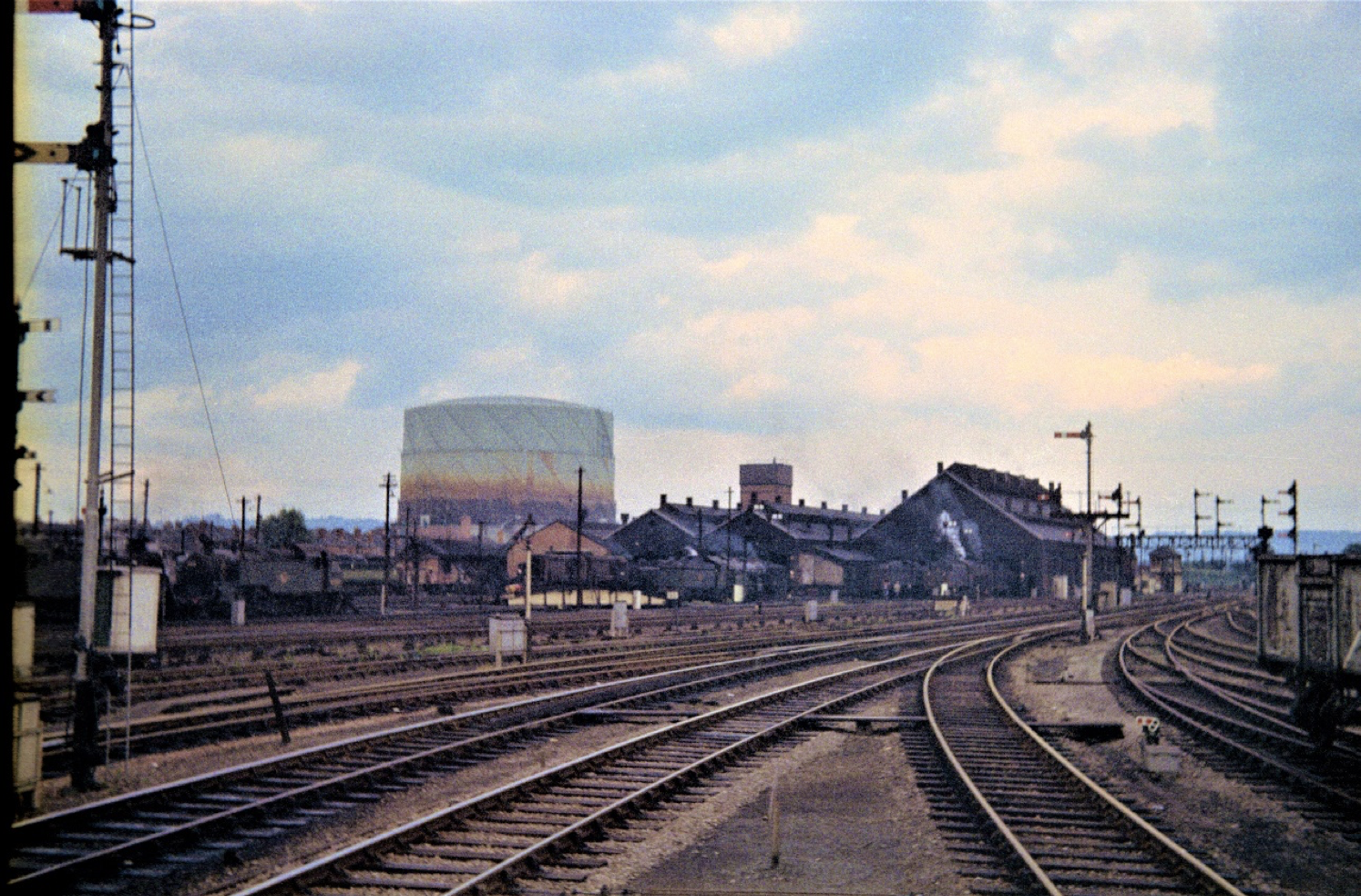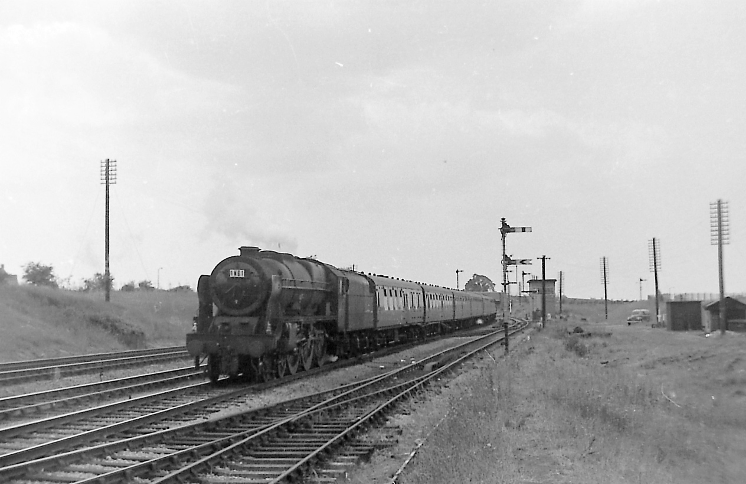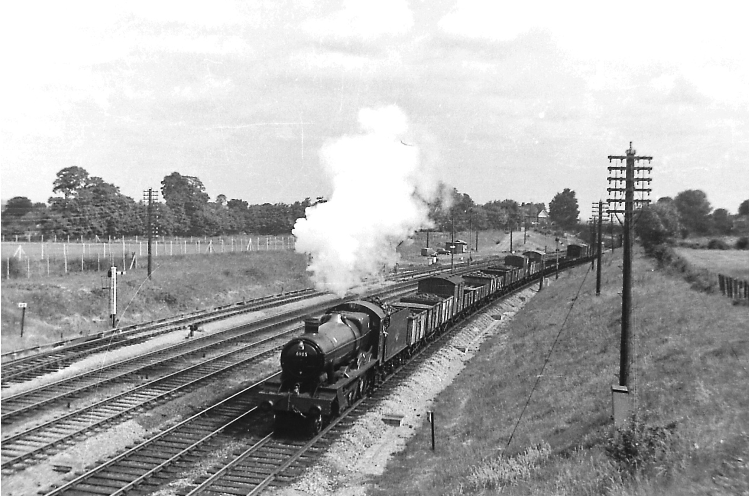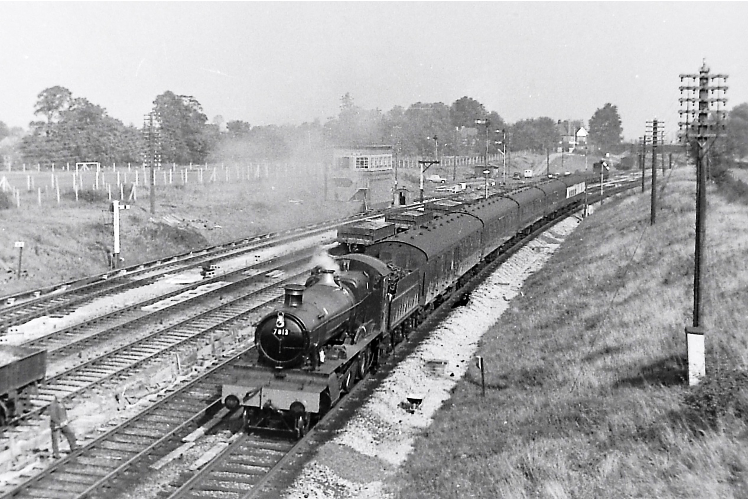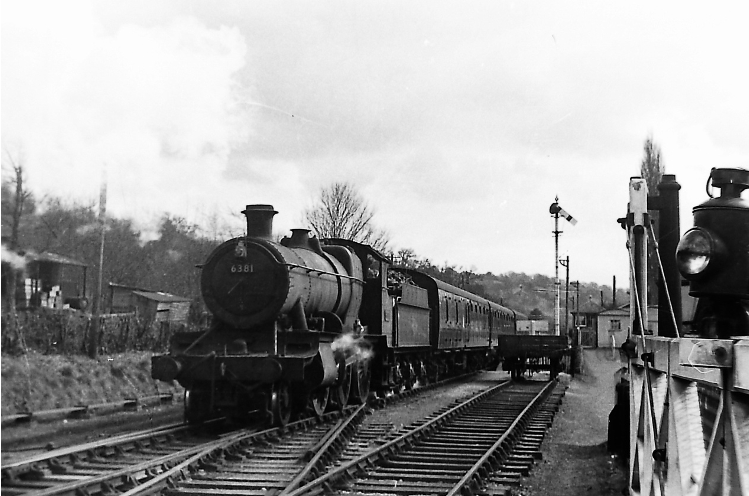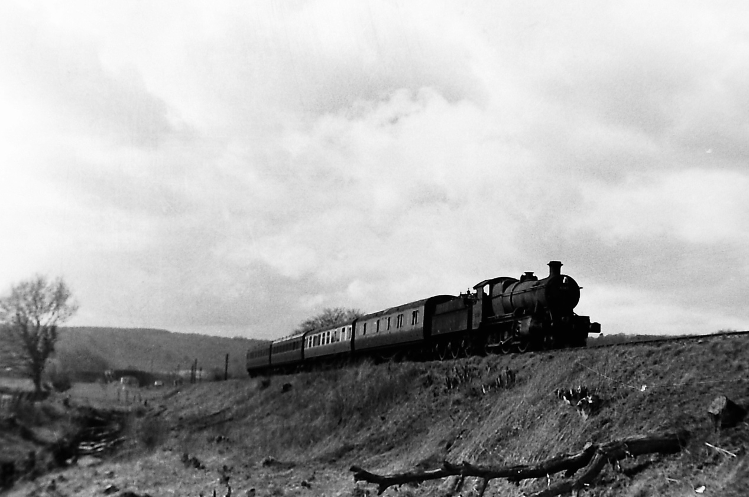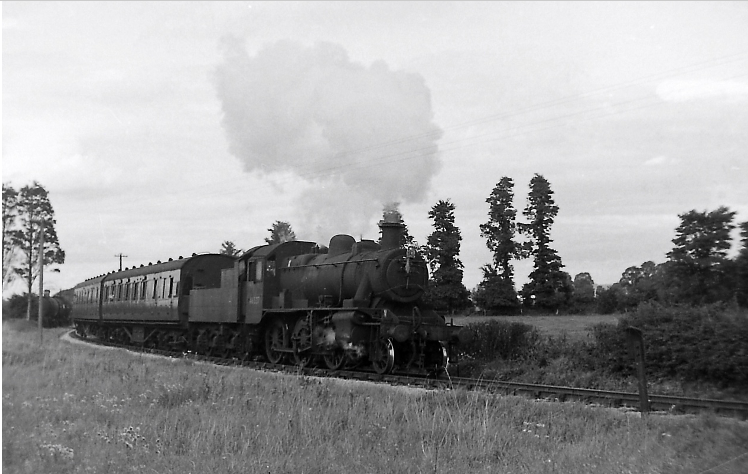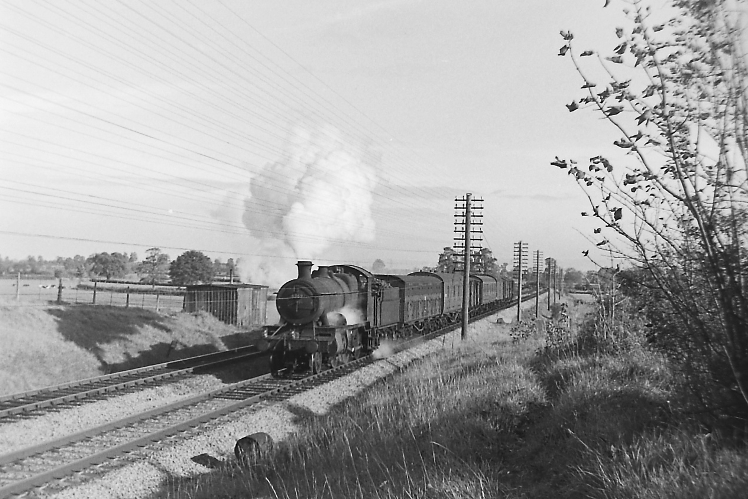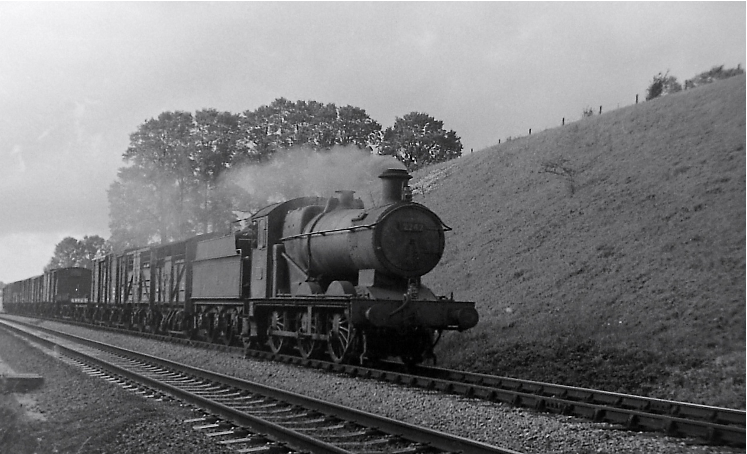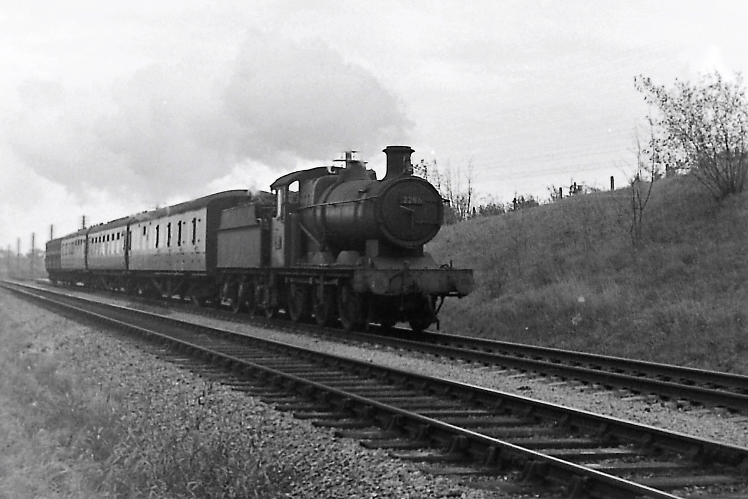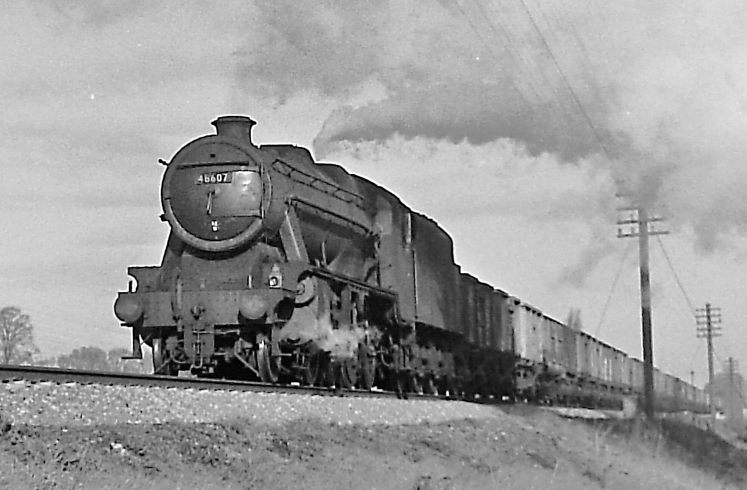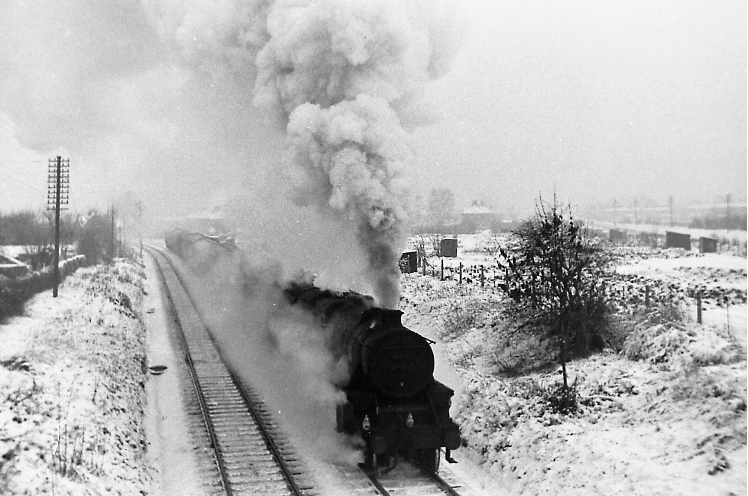1962: GLOUCESTER changes with dieselisation
Change on the Western Region
At the start of 1962, with the appointment of Stanley Raymond to the WR Board, ‘regionalisation’ fell from favour, and it was announced that the ex-GW ‘chocolate and cream’ livery would be phased out, being replaced on express services by the lined maroon livery already used in other regions. Further, in spring, Ernest Marples, the Minister of Transport appointed Dr Beeching to report on the future of British Railways, resulting in the subsequent major reshaping of the railway network.
This was my last full year at home and one when many changes took place on the railway due to wholesale dieselisation through the implementation of the 1955 Modernisation Plan. By now I was busy with my Ilford Sportsman camera, as opportunities to photograph the last of BR steam were declining. Despite not all my photographs surviving, the memories remain potent.
Diesels were now becoming common – ‘Peaks’ had taken over the express workings on the Bristol – Birmingham route, and ‘Warships’ were being used on the Swindon line. In April, the daily 81A ‘Castle’ working from Paddington to Gloucester and return ceased, becoming a ‘Warship’ duty.
The first ‘Western’ class diesel-hydraulic was outshopped from Swindon on trial in November 1961, and by March 1962 new ‘Westerns’ were being run-in on the 6.55am Cheltenham to Paddington from Swindon which unusually stopped at Challow. No. D1002 Western Explorer was recorded on 31 March, and I was hauled by one of the class on the same train on a trip to London on 19 April. On that occasion, I had my first experience of high-speed diesel travel behind brand new No. D1003 Western Pioneer in green livery, accelerating away from Swindon like lightning up to 90 mph before braking for the Challow stop.
The first ‘Hymek’ had been delivered in May 1961 and the early members of the class worked from Bristol allocated to the new diesel depot. From the start of 1962 ‘Hymeks’ were undergoing crew training at Canton and were in service on South Wales trains from March, whilst Landore was closed for conversion into a diesel depot. Gloucester crews were also being trained on ‘Hymeks’ by the summer, and they had a regular Sunday return duty from Gloucester to London. They were also working Paddington – Birmingham trains by May 1962.
Later in the year, Swindon would commence construction of the ill-fated D9500 class diesel-hydraulic locos. This was despite the fact that the new regime under Stanley Raymond had decreed that further diesels with hydraulic transmission should not be built: indeed the very duties for which these locomotives were designed, such as trip freights in the Welsh valleys, were being severely cut back.
1962 would also see the delivery of several prototype second-generation diesel-electric locos. D0280 Falcon appeared in March; D0260 Lion was released in May, whilst DP2 was working on the WCML in May. The first ‘Brush 4’, No. D1500 based on D0280 was outshopped in September. Little did we know the major impact this class would have throughout the system once all 512 members of the class were in service.
Local developments
Modern Railways (the successor of Trains Illustrated) reported in March that a new control room was being commissioned at Northgate Mansions, in Gloucester. One would have thought that it would have been outdated or become redundant rapidly! At this time Brunel’s bridge over the River Wye at Chepstow, similar in design to that across the Tamar at Saltash, was being rebuilt as an orthodox deck bridge.
Steam locos were still very much in evidence, and at the start of 1962 were continuing to work many cross-country expresses, particularly as very cold weather in January caused problems with the steam heating equipment on some diesels. Steam locos could be seen regularly on the 7.35 am Nottingham to Bristol (a 17A turn); 10.15 am Sheffield to Bristol (a 41C turn); and 12.30 pm from Newcastle (another 17A turn). Northbound the 2.15 pm Bristol to Bradford, nominally an 82E turn, and both ‘Pines Expresses’ (rostered for 21A ‘Black 5s’) could also be steam hauled on occasion.
As increasing numbers of new diesels were placed in service, cascading of steam engines proceeded apace. In February no less than 17 ‘Jubilees’ were reallocated to Burton (17B), replacing ‘Crabs’ to provide upgraded power for express brewery freights. Burton’s Reidinger valve-geared ‘Crabs’ were stored out of use by March as 17B acquired yet another 7 ‘Jubilees’! Millhouses MPD closed on 1 January, and its ‘Jubilees’ were put in store at Staveley GC and Barrow Hill; they had been redundant since the advent of the ‘Peaks’ on their passenger turns. However, by April 1962 some found a new home at Agecroft working passenger trains between Manchester and the Fylde coast.
Many of 21As ‘Scots’ which had been employed on freight trains on routes from Birmingham especially to Oxford, including the Fawley oil-trains, were put into store at the start of the summer. Some were later returned to service on the WCML, spending the rest of their days at Carlisle Upperby, whence they were employed on such mundane duties as trip workings to Harrisons sidings at Shap. However, by the end of 1962, many were in store again.
Bristol’s ‘Jubilee’ allocation had been reduced to three, although the un-rebuilt ‘Patriots’ remained on the books until withdrawn in June, along with another 85C stalwart, 0-4-4T No. 41900, which had seen no service since being sent to Wellington for storage. Other local celebrities withdrawn included Nos. 1426 and 4085 Berkeley Castle. Nevertheless, I managed to get a shot of one remarkable survivor, Johnson ‘3F’ 0-6-0 No. 43593, reallocated to Barnwood at the beginning of the year, at the head of a permanent way engineers train as late as 4 September; still in respectable external condition – probably because it remained the pride of the shed!
Steam was still observed in Gloucester in early 1962 including No. 45532 (21A), which was recorded in January on the 2.15pm from York; whilst in February No. 45568 Western Australia worked the Cardiff – Newcastle express. However, probably the most extraordinary appearance in the area was the report of a Polmadie ‘Scot’, redundant from the WCML, No. 46121 Highland Light Infantry, City of Glasgow Regiment which worked the 12.52pm York – Bristol on 24 April returning next day on the 7.40am to Bradford. On 12 May ‘Black 5’ No. 45345 (6H) was photographed on a pigeon special; No. 46103 Royal Scots Fusilier (21A) was seen on 19 May; and No. 45565 Victoria worked the 10.58am to Bristol on 24 May. ‘B1s’ continued to appear sporadically: for example, No. 61313 worked the 10.15am Sheffield – Bristol on 28 May. An unusual combination seen at Gloucester Eastgate on the Kingswear portion of the up Cornishman on 23 June was No. 5089 Westminster Abbey (one of the regular performers on this duty) piloted by ‘Western’ No. D1005 Western Venturer.
‘Royal Scot’ 4-6-0 No. 46151 The Royal Horse Guardsman dawdles past Tuffley Junction under adverse signals at the head of 1N61, the 7.30am Paignton to Newcastle on 7 July 1962.
Fewer ‘7Ps’ were observed working through Gloucester in summer 1962, but ‘Black 5s’ were common, and ‘9Fs’ were still seen on Summer Saturday holiday trains. Increasingly, pigeon specials were now often hauled by WR locos from the Midlands south. Even so, the occasional surprise occurred: for example, in July ‘Britannia’ No. 70049 Solway Firth was recorded on 85C, and on 18 August, 5XP No. 45705 Seahorse was recorded on a pigeon special. And as late as 15 September No. 46109 Royal Engineer turned up at the head of the 10.15am Sheffield – Bristol, doubtless deputising for a failed ‘Peak’.
On 6 July I photographed the Gloucester favourite, ‘Modified Hall’ No. 6985 Parwick Hall, in ex-works condition working the morning pick-up freight to Swindon, at my regular location, Cole Avenue bridge. Ex-works locos from Swindon could still be seen on running-in turns in the autumn of 1962. On Sunday 14 October, engineering work was being carried out in Gloucester and I photographed the Sunday 12.30pm Cheltenham to Paddington at Tuffley Junction, having missed out the Gloucester Central stop, in the hands of an immaculate Manor, No. 7813 Freshford Manor running through to Stonehouse to pick up Gloucester passengers.
One of Gloucester Horton Road’s 4-6-0 ‘Modified Halls’, No. 6985 Parwick Hall running in ex-works on the 10.30am Gloucester New Yard to Swindon pick-up freight passes Tuffley Junction on 6 July 1962.
‘Manor’ class 4-6-0 No. 7813 Freshford Manor heads south past Tuffley Junction with the Sunday 12.30pm Cheltenham to Paddington on 14 October 1962. Permanent way works are being undertaken on the Midland lines, so diversions were taking place using the Western lines.
Photographic excursions
During 1962 I went on several local bicycle trips with my camera to record steam in action as dieselisation was rapidly increasing. On 11 April I followed the route of the Gloucester – Hereford line to photograph steam at Longhope and Blaisdon. The line was normally worked by ‘4300’ class Moguls, ‘Prairie’ tanks or Collett ‘2200’ class 0-6-0s, although by 1964, when the service was due for withdrawal, ‘Manor’ 4-6-0s were more often seen as general dieselisation progressed and older steam locomotives were consigned to the scrap heap. On 26 April I went on a longer bicycle ride in the company of Speck, Troughton and others to Hereford but did not see much as it took three hours to get there. During March, bridge works at Shrewsbury had resulted in more LM engines working through to Hereford, so there was an added incentive to go there. However, by the date of our trip the workings had returned to normal. The ride back was really tiring, but I did take a photo of Ledbury viaduct.
Of course, we had travelled from Gloucester to Hereford by train before, usually taking a trip on an early afternoon train and leaving about tea-time. Apart from the possible sighting of an 84G ‘Castle’ or ‘County’, our main aim was to catch sight of a 9A ‘Scot’, which supposedly worked into Hereford on a Manchester – Plymouth express arriving about 3.30pm. We were mostly disappointed. The only other interesting route was that to Brecon via Three Cocks Junction, as this usually produced an 89B ‘Mickey Mouse’ as the Ivatt 2-6-0s were nicknamed by us. I had always had a desire to ride this line, but the service was very infrequent, and it would not have been possible to return in time for the Gloucester connection. In any case, we were more interested in collecting numbers, and locos would be sparse on routes to Brecon. Passenger services on all the lines through Three Cocks Junction were withdrawn in December 1962.
‘4300’ Class 2-6-0 No. 6381 pulls away from its stop at Longhope with the 2.30 pm Gloucester to Hereford on 11 April 1962.
‘4300’ class 2-6-0 No. 6365 leaves Blaisdon Halt with the 2.43 pm Hereford to Gloucester on 11 April 1962.
On 5 July I cycled to Dowdeswell viaduct to photograph the Kingham line before closure and managed to get a shot of ‘Prairie’ tank No. 4101 on the 2.50pm Cheltenham – Kingham train. This service used the same route from Cheltenham as the M&SWJ route to Swindon as far as Andoversford. The route opened in 1881, crossing the high Cotswolds to Kingham, but did not last much longer and was finally closed to traffic from 15 October 1962. I only managed to travel on this route once when our family took a day excursion trip to Oxford via Kingham. On arrival at Oxford, we were taken to the Thames for a Salter’s boat trip to Abingdon, seeing the auto-train from Abingdon to Radley cross the river on the way. If I remember rightly, we returned to Oxford by bus to catch our return train to Cheltenham. I also cycled to the Stroud valley and Badminton in that month, taking photographs.
At the end of summer service another local service succumbed to closure: the branch from Coaley Junction to Dursley, known colloquially as the ‘Dursley Donkey’. I never travelled this line but did manage to photograph Ivatt ‘2’ 2-6-0 No. 46527 at the head of the last train on 8 September.
Ivatt ‘2’ 2-6-0 No. 46527 leaves Coaley Junction with the ‘Dursley Donkey’ at 4.40 pm on the last day of operation of the Dursley branch, 8 September 1962.
In November I cycled out to the South Wales line at Highnam, as the Hereford line still being worked by steam, mainly Moguls and Collett 0-6-0s.
‘4300’ Class 2-6-0 No. 6369 bustles westward towards Highnam with the 11.20am Gloucester to Cardiff parcels on 1 November 1962. The mixed rake includes an ex-GW Siphon G next to the engine.
The driver has closed the regulator of Collett 0-6-0 No. 2242 as it coasts up to the A48 road-bridge at Highnam on the approach to Gloucester with the 8.00am Hereford to Gloucester Old Yard pick-up freight on 1 November 1962. Note the cattle wagons, marshalled as usual next to the locomotive.
Collett 0-6-0 No. 2286 at Highnam at the head of the 12.40 pm Gloucester to Hereford on 1 November 1962.
With the commencement of the winter timetable, a wholesale reorganisation and acceleration of cross-country services occurred using the ‘Peaks’ to their full capability. As a result, major substitution of diesels for steam traction occurred that autumn. The ‘Devonian’ now ran non-stop between Birmingham and Bristol, whilst the ‘Pines Express’ was rerouted away from Gloucester altogether, running via Market Drayton, Oxford and Basingstoke, albeit still steam-worked south of Wolverhampton.
On 7 September 1962 the ‘Cornishman’ ran for the last time in its GW guise, with ‘Castle’ No. 7001 Sir James Milne at its head. After that time, the ‘Cornishman’ was diverted from Wolverhampton and the GW route to run from Bradford via the Midland main line. Ironically, the locomotive was named after the last General Manager of the Great Western Railway, a man implacably opposed to nationalisation and the creation of British Railways in 1948.
The through service from Newcastle to Cardiff was extended to Swansea, and an additional Cardiff – Leeds service introduced. The Inter-city DMU service between Birmingham and Cardiff was also diverted away from the Honeybourne line, extended to Derby, and rerouted via the Midland line to Birmingham. This service was worked by Inter-city units with wrap-round windows in the W52000 series.
[By 1988 the Cardiff – Nottingham service – as it had become – was being worked by cl 155 units and at present (2020) are in the hands of Cross County cl 170 units].
Despite these changes locally, freight traffic was still important, and in autumn processions of coal trains could still be noted going south at weekends. As these were additional non-timetabled trains, their locomotives often returned light, and on occasion it was possible to see as many as five light engines coupled together working back northwards from Westerleigh on a Sunday afternoon, comprising a mixture of ‘4Fs’, ‘8Fs’ and other classes.
Stanier ‘8F’ 2-8-0 No. 48607 battles against a north-westerly sidewind, portent of a hard winter to come, as it heads south on Western tracks having come off the Gloucester avoiding line. It is crossing Grange Lane bridge with an extra coal train for Westerleigh on Sunday 16 December 1962.
At the end of the year, massive withdrawals of main-line steam locos were taking place across the regions, yet in the run-up to Christmas steam still worked some passenger trains: for example ‘Jubilee’ No. 45579 Punjab was photographed by Ben Ashworth at California Crossing on the 10.58am to Bristol on Christmas Eve, whilst ‘Black 5’ No. 45438 worked the down ‘Devonian’ on 30 December. This heralded the start of the most severe winter since 1947, so consequently, even at this late stage, steam locos would have to be drafted in to come to the aid of frozen-up diesel locomotives.
‘Black 5’ 4-6-0 No. 44776 struggles up the 1 in 108 gradient from Painswick Road Crossing to Tuffley Junction at the head of the late running Derby to Bristol parcels train. The date is 29 December 1962, with freezing fog heralding the start of the coldest winter in living memory.
